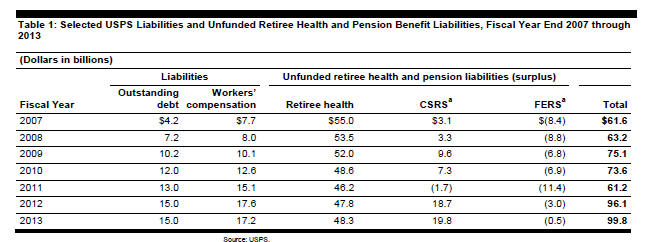GAO: Action Needed to Address Unfunded Benefit Liabilities
 USPS continues to be in a serious financial crisis, with insufficient revenue to cover its expenses and financial obligations as the volume of USPS’s most profitable product, First-Class Mail, continues to decline. At the end of fiscal year 2013, USPS had about $100 billion in unfunded liabilities: $85 billion in unfunded liabilities for benefits, including retiree health, pension, and workers’ compensation liabilities, and $15 billion in outstanding debt to the U.S. Treasury—the statutory limit. These unfunded liabilities are a large and growing financial burden, increasing from 83 percent of USPS revenues in fiscal year 2007 to 148 percent of revenues in fiscal year 2013. Unfunded benefit liabilities represent estimated future benefit payments to current and retired employees for which USPS has not set aside sufficient money to pay. This testimony discusses (1) the extent to which USPS’s benefit liabilities are unfunded and (2) the potential impacts.
USPS continues to be in a serious financial crisis, with insufficient revenue to cover its expenses and financial obligations as the volume of USPS’s most profitable product, First-Class Mail, continues to decline. At the end of fiscal year 2013, USPS had about $100 billion in unfunded liabilities: $85 billion in unfunded liabilities for benefits, including retiree health, pension, and workers’ compensation liabilities, and $15 billion in outstanding debt to the U.S. Treasury—the statutory limit. These unfunded liabilities are a large and growing financial burden, increasing from 83 percent of USPS revenues in fiscal year 2007 to 148 percent of revenues in fiscal year 2013. Unfunded benefit liabilities represent estimated future benefit payments to current and retired employees for which USPS has not set aside sufficient money to pay. This testimony discusses (1) the extent to which USPS’s benefit liabilities are unfunded and (2) the potential impacts.
What GAO Found
The extent to which the U.S. Postal Service (USPS) has funded its liabilities varies due to different statutory funding requirements specific to each benefit program and USPS’s financial means to make payments. For example, USPS has been required to prefund its pension benefit liability over decades, and as shown in the table below, its pension liability is 94 percent funded. Prefunding USPS’s retiree health benefits began in 2007, and the liability is about half funded. In contrast, USPS funds its workers’ compensation benefits on a pay-as-you-go basis, and the entire liability is unfunded. The largest unfunded liabilities, in order of decreasing size, are $48 billion for retiree health, $19 billion for pensions, and $17 billion for workers’ compensation. The rules for calculating the amount that USPS must fund each year differ among the pension and retiree health programs, including variations in amortization periods, recognition of any surpluses, use of actuarially determined versus fixed payments, and actuarial assumptions.
GAO
GAO has previously reported that without congressional action to address USPS’s benefit funding issues and better align its costs and revenues, USPS faces continuing low liquidity levels, insufficient revenues to make annual prefunding payments, and increasing liabilities. Deferring funding could increase costs for future postal ratepayers and increase the possibility that USPS may not be able to pay for these costs. GAO has previously identified the following key considerations related to USPS’s funding of its benefits liabilities:
Reasons for prefunding include fairly allocating costs between current and future ratepayers, protecting USPS’s future viability, providing greater benefit security to employees and retirees, and protecting potential third parties.
Prefunding decisions involve trade-offs between USPS’s current financial condition and its long-term prospects.
Congress needs to modify USPS’s retiree health prefunding payments in a fiscally responsible manner, and USPS should prefund any unfunded retiree health benefits liability to the maximum extent that its finances permit.
Lowering the retiree health funding target from 100 to 80 percent would have the effect of carrying a permanent unfunded liability.
USPS liabilities are estimated using assumptions for the federal workforce as a whole, rather than USPS-specific assumptions. GAO supports the use of the most accurate actuarial assumptions available, and if USPS-specific assumptions are used, that they be recommended by an independent body.
USPS’s benefit liabilities are actuarial estimates of the present value of a portion of the future benefits projected to be paid under each program based on formulas in current law. Specifically, for both the pension and retiree health programs, the liability includes two pieces: (1) the present value of all projected future benefits for current retirees and their beneficiaries, plus (2) the present value of a portion of the projected
future benefits for current employees and their beneficiaries, based on employees’ service to date (with each additional year of service adding to the liability, such that approximately the full liability is accrued when employees reach retirement).6 Contrary to statements made by some employee groups and other stakeholders, these liabilities do not include any amounts for future USPS employees not yet hired or born. The workers’ compensation liability represents the present value of all projected future benefits for former employees who have sustained an injury and are eligible for benefits; it does not include a provision for projected future injuries to current employees.
These liability measurements depend on a combination of economic and demographic assumptions regarding such factors as future investment returns, interest rates, inflation, salary increases, medical costs, and longevity. These liability measurements inherently contain significant degrees of uncertainty, and can change from year to year, both because of actual experience differing from the assumptions and because of changes to the assumptions themselves, which can occur in response to emerging experience and changing conditions. As an example of the
sensitivity of these liabilities to changes in assumptions, USPS has estimated that its $48 billion unfunded liability for retiree health benefits could have ranged from $35 billion to $64 billion, solely by varying the inflation rate by 1 percent in either direction.
USPS’s pension and retiree health liabilities are estimated using demographic and pay-increase assumptions developed for the federal workforce as a whole, rather than assumptions developed for the USPS workforce in particular. Some have suggested that USPS’s benefit liabilities may be overstated in that the use of USPS-specific assumptions would result in a lower liability measurement.7 In 2013, we testified that we support using the most accurate numbers possible. We suggested that if USPS-specific assumptions are used, the assumptions should continue to be recommended by an independent body (such as OPM’s Board of Actuaries).
read full report:Todisco-GAO-Statement-USPS-Unfunded-Liabilities-3-13

Hey Get Real: Why won’t your boy Issa put his crap up for a vote?
btw, I paid union dues for over thirty years chump! Still paying them
in retirement (@ reduced rate).
No one has said unions are perfect, certainly not me.
If not for the unions, postal workers would have Wal-Mart wages, conditions and rights.
What happened, you lose a grievance? Wah, wah, wah.
The only articulation you are doing is reading Issa’s talking points.
Plain and simple, you’re a clueless hater.
What postal worker in their right mind would want 5 day delivery? If you don’t like it, please do us all a favor and retire.
In such a corrupt enterprise as the USPS you need a little corruptness [ the union]in your corner to survive.
So the nalc has been lying all along. LOL
@Renaldo
I’ve seen your posts as well, you’re a pathethic Union Hack, living off all the hard work that dues paying employees like myself pay…..The problem is you and your cronies are about as bad as Postal Management in doing anything for the Workers…..First chance you get to solidify the numbers of dues paying members, I’m talking about the new CCAS, and you throw them under the bus by agreeing to reduce their pay…….Next the Unions get the prepayment of Health Benefits passed in Congress and since it creates a financial hardship and adds fuel to the argument to eliminate Saturday delivery, the Unions reverse their position and oppose it……..All because it will reduce the number of dues paying employees…..Next comes an assessment to maintain the Union Coffers because so many Employees are getting out of the Union due to the Unions self serving themselves rather than bending to the will of the majority who want 5 day delivery..
….Its sad to see a grown person reduced to name calling when they can’t articulate an argument to support their position….
Serious Financial crisis? Many facilities offer OT.everyday.
Hey Get Real- do you have a life other than bashing the Postal Service?
What a pathetic hater with nothing better to do than post ignorant comments you have no knowledge of. Seriously, what’s with your hanging around postal websites spewing your ignorance?
Are you a plant from Issa’s office?
Get a clue and get a life, pathetic loser!
Figures , figures , figures ! Liars figure , but figures don’t lie ! HM-m-m- think that old saying still valid ?
All their estimates for workers compensation are way out of line as I believe the entire work force, in the future will be injured and utilizing workers comp., due to the unsustainable work methods currently in use delivering mail.
The turning, twisting, and reaching are going to take its toll on carriers. Shoulder surgeries are going to be the normal business as usual…..
NO MORE BONUS FOR THOSE MGMT.